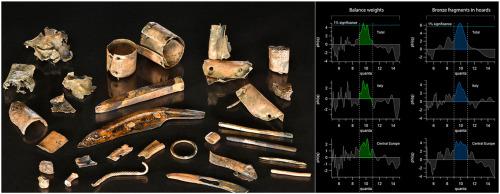Journal of Archaeological Science ( IF 2.6 ) Pub Date : 2021-04-14 , DOI: 10.1016/j.jas.2021.105379 Nicola Ialongo , Giancarlo Lago

|
In the Bronze Age (c. 2300–800 BC), European communities gave up their economic independence and became entangled in a continental trade network. In this paper, we will test the hypothesis that the adoption of a ‘Pan-European’ currency has favoured the development of such a network. We define a methodology to test the money-hypothesis in pre-literate economies, based on analogies with the material characters of metallic money in the Ancient Near East. The statistical properties of metals from European hoards are compared with those of balance weights, in order to test the following expectation: if they were used as money, complete objects and fragments are expected to comply with standard weight systems. The results meet the expectation, and indicate that bronze fragments possess the same statistical properties as hack-silver money in the Ancient Near East. The sample includes approximately 3000 metal objects, collected from two test-areas: Italy and Central Europe. The sample of balance weights includes all the items known to date for pre-literate Bronze Age Europe, collected within the framework of the ERC Project ‘Weight and Value.’
中文翻译:

零钱革命。体重系统和首个泛欧洲货币的出现
在青铜时代(约公元前2300-800年),欧洲社区放弃了经济独立并陷入了大陆贸易网络中。在本文中,我们将检验以下假设:采用“泛欧”货币有利于这种网络的发展。我们基于古代近东地区金属货币的物质特征,定义了一种方法来测试识字前经济体中的货币假设。为了检验以下预期,将欧洲ho积金属的统计特性与平衡重的统计特性进行了比较:如果将它们用作货币,则完整的物体和碎片应符合标准的重量系统。结果符合预期,并表明青铜碎片具有与远古远古时期的黑银货币相同的统计特性。样本包括从两个测试区域收集的大约3000个金属物体:意大利和中欧。平衡重样本包括在ERC项目“重量和价值”框架下收集的,迄今为止识字欧洲青铜时代之前已知的所有项目。











































 京公网安备 11010802027423号
京公网安备 11010802027423号